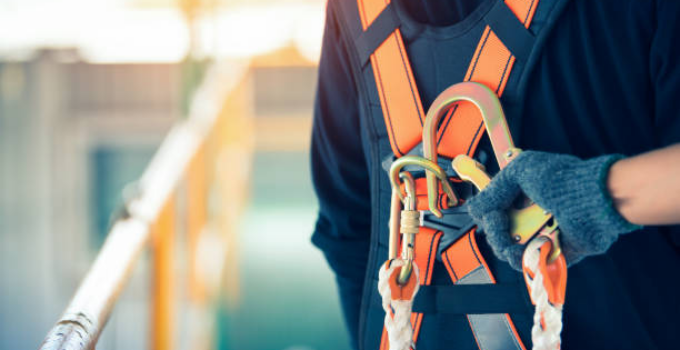The construction industry is among the most hazardous sectors in which to work. Understand the construction safety protocols, emphasizing the importance of a robust fall protection system and the role ofsafety gear in ensuring a secure environment. Explore the fundamental construction site safety rules and regulations that shape our projects.
At Coreconstruct, we Uncover what construction safety entails as we navigate the intricacies of maintaining a safe workspace within commercial interiors. Join us on a journey to understand the critical elements that underpin a successful construction project, where adherence to construction site safety rules and regulations is paramount.
Table of Content
What Are The Commercial Interiors Construction Site Safety Rules?
Why Is Construction Site Safety Essential?
● Significance of Construction Safety
● Impact of Neglecting Safety Rules and Regulations
● Role of Construction Safety in Protecting Lives
● Importance of Fall Protection Systems
● Ensuring Compliance with Safety Protocols
Impact of Safety Rules on Company Work Ethics: Fostering a Culture of Safety
● Use the Right Tools and Equipment
● Following Strict Safety Protocol
● Encouraging Questions and Clarifications
● Managing Specific Movement at the Site: Streamlining Operations for Safety

Why Is Construction Site Safety Essential?
According to OSHA, accidents in construction sites are not just numbers; they represent lives at risk and well-being compromised. Understanding why construction site safety is essential goes beyond compliance—it’s about safeguarding every individual involved in construction projects and fostering a culture of responsibility toward safety.
● Significance of Construction Safety
In the construction industry, where hazards lurk in every corner, prioritizing construction safety is non-negotiable. It involves a collective effort to uphold the highest standards of safety practices and protocols to prevent accidents and protect the workforce.
● Impact of Neglecting Safety Rules and Regulations
Adherence to construction site rules and regulations can have dire consequences. Accidents, injuries, and even fatalities can occur when safety measures are overlooked or neglected. The cost of such incidents extends beyond financial implications to impacting the lives of workers and their families.
● Role of Construction Safety in Protecting Lives
Construction Safetyisn’t just a set of guidelines; it’s a shield that guards against potential dangers. From ensuring the proper implementation of fall protection systems to equipping workers with adequate safety gear, every safety measure is a lifeline that protects individuals from harm.
● Importance of Fall Protection Systems
Fall-related incidents are among the leading causes of injuries and fatalities in construction. Implementing robust fall protection systems such as guardrails, harnesses, and safety nets is crucial in preventing falls from heights and minimizing the risks associated with working at elevated levels.
● Ensuring Compliance with Safety Protocols
Structured construction safety protocols are key to maintaining a safe work environment. Regular safety inspections, hazard assessments, and emergency response procedures form the backbone of a proactive safety culture that safeguards everyone on the construction site.
Check out Ten Things You Need To Know About Construction Site Safety.

Impact of Safety Rules on Company Work Ethics: Fostering a Culture of Safety
Adhering to construction site safety rules goes beyond mere compliance—it reflects a company’s core values and ethics. By prioritizing safety, organizations protect their workforce and demonstrate their commitment to upholding high standards of work ethics.
● Create Site Awareness
Creating site awareness is crucial in ensuring that everyone working on the site understands the importance of safety. Companies can empower employees to make informed decisions that prioritize safety through regular safety briefings, workshops, and training sessions.
● Emergency Management System
An efficient emergency management system is vital in handling unforeseen situations swiftly and effectively. Companies can ensure their workforce is well-prepared to handle emergencies with composure and efficiency, from conducting drills to designating emergency response teams.
● Conducting Daily Meetings
Daily meetings are a platform for discussing safety updates, addressing concerns, and reinforcing safety protocols. These meetings promote open communication, collaboration, and the sharing of best practices, fostering a culture where safety is a collective responsibility.
● Arranging First Aid Kits
Having readily accessible first aid kits on-site is essential in providing immediate medical assistance in case of injuries or emergencies. Regularly checking and restocking these kits ensures workers access necessary supplies to address minor injuries promptly.

● Wear Protective Gear
Safety gear acts as a shield against potential hazards on the construction site. From helmets and gloves to goggles and high-visibility vests, wearing protective gear is non-negotiable to safeguard workers from injuries and ensure their well-being.
● Fall Protection System
Falls are among the most common causes of injuries in construction. Implementing a robust fall protection system, including guardrails, safety nets, and harnesses, is essential in preventing falls from elevated surfaces and minimizing the risks associated with working at heights.
● Adequate Supply of Water
Maintaining an adequate water supply on the site is essential to keep workers hydrated, especially during hot weather or physically demanding tasks. Proper hydration not only promotes health but also enhances alertness and productivity.
● Keep the Job Site Clean
A clean job site is a safe job site. By keeping work areas clear of debris, clutter, and hazards, companies reduce the risk of slips, trips, and falls, creating a safer environment for everyone on-site.
● Use the Right Tools and Equipment
They use appropriate tools and equipment for specific tasks to ensure efficiency and safety. Companies should provide workers with properly maintained tools and equipment and emphasize the importance of using them correctly to prevent accidents.
● Following Strict Safety Protocol
Safety protocols are put in place for a reason—to protect individuals from harm. By strictly following safety protocols, companies instill a culture of safety consciousness and ensure every task is carried out to minimize risks and promote well-being.

● Encouraging Questions and Clarifications
Encouraging workers to ask questions whenever they are in doubt fosters a culture of transparency and proactive safety awareness. Clearing doubts, seeking clarification, and promptly addressing uncertainties contribute to a safer work environment.
● Managing Specific Movement at the Site: Streamlining Operations for Safety
Managing specific movement at the site involves planning and coordinating activities to prevent congestion, minimize risks, and ensure smooth operations. Companies can enhance safety and optimize workflow by accomplishing schedules efficiently and strategically.
● Make Daily Reports
Daily reports play a crucial role in monitoring safety performance, tracking progress, and identifying trends or patterns that may indicate areas for improvement. By maintaining thorough and accurate records, companies can proactively address safety issues and continually enhance their safety protocols.
Check out 11 Construction Safety Tips to Avoid Construction Site Hazards.
Wrap-Up
As we wrap up our exploration of construction site safety rules for commercial interiors, we hope you’ve gained a deeper understanding of the critical aspects of Construction Safety. Remember, adhering to construction site rules and regulations isn’t just a requirement—it’s a commitment to the well-being of everyone on the job site.
By prioritizing fall protection systems, equipping workers with proper safety gear, and following stringent construction safety protocols, we pave the way for a safer and more productive work environment.
Let these guidelines serve as a beacon of best practices in the construction industry, guiding you towards excellence in safety standards. Embrace the power of knowledge and proactive safety measures to create a workplace where safety is a priority and a culture.
Stay tuned for more insightful content and captivating images to enrich your journey toward enhanced construction site safety. Thank you for joining us on this safety-centric adventure!
FAQs
What are the safety rules for working in high places?
Safety rules for working at heights include using fall protection gear, securing ladders and scaffolds properly, and ensuring regular safety inspections to prevent accidents.
What is the construction of the First Aid kit, and what are its items?
A construction First Aid kit typically includes bandages, antiseptic wipes, gloves, gauze pads, adhesive tape, scissors, and a CPR mask for immediate medical assistance on-site.
How does constant communication prevent construction site hazards?
Effective communication among team members ensures that safety protocols are clear and followed consistently, enabling quick responses to potential hazards and minimizing risks on the construction site.




